WHO WAS THE INCA PACHACUTEC ?
THE INCA PACHACUTEC (1418 - 1471)
Pachacutec (1418 -1471), also called "Pachacutec Inca Yupanqui" was the ninth Inca ruler who exchange the small regional state for a vast an prosperous empire, which included part of the current territories of Peru, Bolivia, Ecuador, Colombia, Argentina and Chile. His name means "World Transformer". According to the English historian Clement Markham, he was the greatest man of the aboriginal race than America has ever produced"
 |
| The Inca Pachachutec 9th ruler of the Inca Empire during the period 1418 - 1471 |
 |
| Monument to Pachacutec in Cusco, Peru |
The Inca Pachacutec led the expansionist process through conquest and alliance with the subjugates peoples. Then the empire grew so quickly that it had to create the new "Tahuantinsuyo" (The Inca empire divided into 4 regions) to better manage the new limits of its territory.
According to research carried out with carbon 14, the citadel of Machupicchu was built in 1450 when the empire of the famous Inca Pachacutec ruled. For its edification he brought groups of thousands of men belonging to the recently conquered people from distant lands.
It is believed that the construction of Machupicchu had several purposes. The first is that it served as the provisional residence of the Inca Pachacutec and his family. It is also believed that it served as a lookout post over the eastern kingdoms. Finally, it hat the purpose of a temple and a place of residence for approximately a thousand people.
According to some chroniclers the real name of Machu Picchu was "Patallaqta", the place that Pachacutec would have chosen to be buried. Some researchers suggest that the mummy of the Inca is found there. Others believe that is located in the San Blas neighborhood in the city of Cusco. Some even point out that they are buried under the San Andrés hospital in Lima. The truth is that no one has found these remains.
Other works that are attributed to the Inca Pachacutec are:
- Reconstruction of the Koricancha Temple in the City of Cusco.
- Reconstruction of the city of Cusco, with squares, neighborhoods and palaces.
- Reconstruction of the Koricancha fortress also known as the Temple of the Sun.
- Construction of the citadel of Ollantaytambo in the Sacred Valley.
- Construction of hundreds of kilometers of the "Qhapac Ñan" road network.
- Establishment of the Wawa Inti Raymi Festival.
- Manpower obligation for the benefit of the Inca state.
 |
| Citadel of Machu Picchu built during the government of the Inca Pachacutec |
 |
| Edifications in Ollantaytambo built during the government of the Inca Pachacutec |
 |
| The Koricancha or Temple of the Sun also built during the government of the Inca Pachacutec |

Comments
Post a Comment